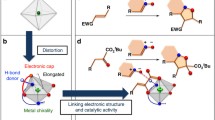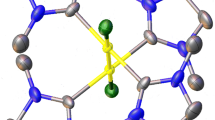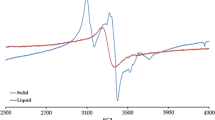Abstract
Complexes of N(1)-methyl- and N(1)-benzyl-2-(dimethylphenylazo)imidazoles with ruthenium(II) have been prepared and characterised by physico-chemical and spectroscopic means. The 7,8-dimethylphenylazo ligands gave four stereoisomers, whereas the 8,9-dimethylphenylazo ligands gave only two. Isomer assignments are made on the basis of i.r. and 1H-n.m.r. data. Redox studies show the RuIII/II couple at 0.4–0.5 V (versus s.c.e) for the trans,cis,cis-isomers, whereas the other isomers exhibit higher (0.6–0.7 V) potentials. Two successive azo reductions are observed at negative potentials. The difference between the first metal and ligand redox potentials is linearly correlated with νCT [t2(Ru) → π*(RL)].
Similar content being viewed by others
References
T.K. Misra, D. Das, C. Sinha, P. Ghosh and C.K. Pal, Inorg. Chem., 37, 1672 (1998).
T.K. Misra, D. Das and C. Sinha, Polyhedron, 16, 4163 (1997).
D. Das, T.K. Misra and C. Sinha, Transition Met. Chem., 23, 73 (1998).
P. Chattopadhyay, B.K. Dolui and C. Sinha, Indian J. Chem., 36A, 429 (1997).
D. Das, M.K. Nayak and C. Sinha, Transition Met. Chem., 22, 172 (1997).
D. Das and C. Sinha, Transition Met. Chem., 23, (1998) (in press) and refs. therein.
P. Chattopadhyay, C. Sinha, and D.K. Pal, Fresenius J. Anal Chem., 357, 368 (1997).
R.A. Krause and K. Krause, Inorg. Chem., 23, 2195 (1984) and refs. therein.
A.R. Chakravarty and A. Chakravorty, Inorg. Chem., 20, 275 (1981).
N. Bag, G.K. Lahiri, and A. Chacravorty, Inorg. Chem., 31, 40 (1992) and refs. therein.
C.K. Pal, S. Chattopadhyay, C. Sinha and A. Chakravorty, Inorg. Chem., 35, 2442 (1996) and refs. therein.
C. Place, J.-L. Zimmermann, E. Mulliez, G. Guillot, C. Bois and J.-C. Chottard, Inorg. Chem., 37, 4030 (1998).
J. Abe and Y. Shirai, J. Am. Chem. Soc., 118, 10389 (1996).
E.C. Constable, Coord. Chem. Rev., 93, 205 (1989).
C. Anderson and A.L. Beauchamp, Inorg. Chem., 34, 6065 (1995).
A. Hatcidimitriou, A. Gordon, J. Devillers, J.P. Launacy, E. Mena and E. Amouyal, Inorg. Chem., 35, 2215 (1996).
F.A. Cotton, Chemical Application of Group Theory, 2nd Edit, Wiley Eastern Ltd, New Delhi, 1970.
A.B.P. Lever, Inorganic Electronic Spectroscopy, Elsevier, Amsterdam, 1968.
A.B.P. Lever, Coord. Chem. Rev., 63 (1982).
B.K. Ghosh, A. Mukhopadhyay, S. Goswami, S. Ray and A. Chakravorty, Inorg. Chem., 23, 4633 (1984).
Author information
Authors and Affiliations
Rights and permissions
About this article
Cite this article
Misra, T.K., Santra, P.K. & Sinha, C. Use of steric crowding to synthesise ruthenium(II) N(1)-alkyl-2-(arylazo)imidazole isomers. Spectral characterization and redox studies. Transition Metal Chemistry 24, 672–677 (1999). https://doi.org/10.1023/A:1007047912100
Issue Date:
DOI: https://doi.org/10.1023/A:1007047912100




